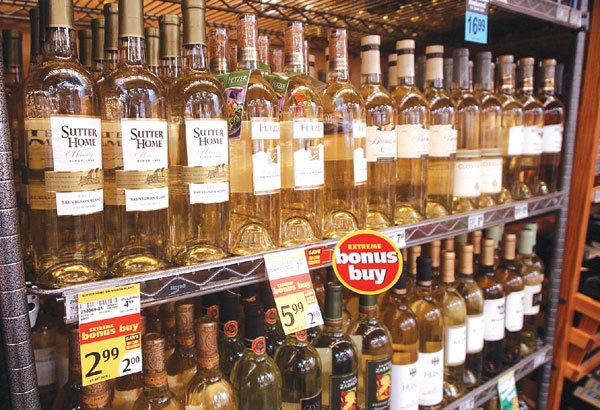GILROY
– Leave it to a recession year for the surge in popularity of $2
and $3 bottles of wine.
GILROY – Leave it to a recession year for the surge in popularity of $2 and $3 bottles of wine.
Statewide, the most famous new brand is Charles Shaw, aka “Two-Buck Chuck,” but since it’s sold exclusively at Trader Joe’s stores, you can’t get it in Gilroy.
Not to fear, local drinkers of cheap vino. For the past year, Nob Hill Foods has sold its own California Arbor, which also weighs in at $1.99 a bottle.
“Right now, it’s our number-two-selling wine,” Nob Hill spokeswoman Nicole Townsend said Friday.
The success of the so-called supervalue wines came at a price – California wine shipments for 2003 were up 4 percent, but the estimated retail value increased only 2 percent, The Associated Press reported.
Still, bigger volume was a positive sign for the California wine industry, which has struggled in recent years as a world grape glut, domestic doldrums and popular imports pushed down sales and backed up inventories.
Are wine drinkers’ tastes becoming cheaper?
Yes and no is the enigmatic answer. Nob Hill’s number-one seller is Kendall-Jackson Chardonnay, which falls into the more typical $10 to $15 price range for a 750-mL bottle.
On the other hand, Nob Hill has “noticed a trend toward people buying the less expensive wines,” Townsend said. “We are … carrying more of the less-expensive-type wines in order to meet our customers’ needs.”
For micro-wineries like those in the Santa Clara Valley, the results are mixed. Family owners of two local wineries on Hecker Pass Highway say they aren’t seeing their customers’ tastes get cheaper.
Solis Winery actually reports that its more expensive varieties are selling better – perhaps a backlash against the mass-produced libations.
“We’re noticing that people who are visiting the winery here at our tasting room are gravitating toward our higher-priced wines,” Solis co-owner Valerie Vanni said, “although we still have a very strong demand for our … value-priced brands … in the $8 to $12 range.”
Per-capita spending at Solis has increased from $12 to $33 per adult, Vanni said. Solis’ wines range in price from $8 to $22, plus one super-premium variety priced at $34.
“In the last three years, the number of wine drinkers has increased by six million, which is good for us,” Vanni said.
At nearby Fortino Winery, however, Vice President Teri Fortino said one cannot discount the impact of discount wine.
“Two-Buck Chuck has really affected the wine industry,” Fortino said. “You definitely see the same number of people coming through the tasting room, but they’re not buying the volume that they used to buy. Where they used to purchase in case lots, they now purchase three of four bottles.”
Fortino wines range in price from $9 to $25 a bottle.
No California Arbor could be found at Gilroy’s Nob Hill supermarket on Sunday or Monday, but $2.99 bottles abounded.
These aren’t your typical Ripple, Thunderbird or Boone’s Farm; they seem aimed to compete with wines that cost five times as much. Instead of fruity varieties, California Arbor comes in Chardonnay, cabernet, merlot and shiraz. Charles Shaw has a similar array.
Nevertheless, wine-buying hasn’t changed for people like Ursula Bauer, 82, of Gilroy. Shopping at Nob Hill Monday, she bought three bottles in the middle price range: Blue Nun from Germany, California Chardonnay and champagne.
Bauer said she doesn’t like the new, relatively cheap Australian wines, and while she’s noticed the increasing number of $3 wines, she doesn’t touch them.
“I don’t buy that,” she said. “I don’t like that.”
California wineries shipped 417 million gallons throughout the United States in 2003, according to the Gomberg-Fredrikson Report. The San Francisco-based Wine Institute, which released the figures Thursday, estimates the retail value of those shipments at $14.3 billion.
Including international markets, California wine shipments grew by 6 percent, to 494 million gallons, reflecting increased marketing efforts as well as the weakening of the dollar.
“The good news is that all the discounting increased consumption, probably brought in some new consumers and especially the young consumers,” wine industry analyst Jon Fredrikson said. “Consumers are wise; they buy when there are bargains around, and they stepped up and bought a lot more wine last year.”
Supervalues, wines selling for $3 or less a bottle, continued to be a big part of the sales picture, selling 6.8 million cases, which amounted to 13 percent of all California wine shipments in-state.
Two other key factors in 2003 were the success of Australian imports, in particular the Yellow Tail brand, and the four-and-a-half-month-long employee strike and lockout in Southern California grocery stores, Fredrikson said.
Despite that, sales of California wines priced at $7 and above increased 6 percent, accounting for 30 percent of the volume and 62 percent of winery revenues. Wines selling for $7 or less increased by 5 percent, accounting for 70 percent of volume and 38 percent of winery revenues.
Fredrikson expects conditions for the industry to improve more this year, with the sinking dollar making U.S. wines more attractive abroad and indications that the 2001 vintage, just now being released, was a good one for California.
The Associated Press contributed to this report.













